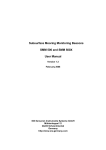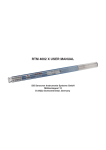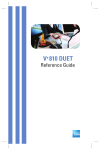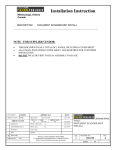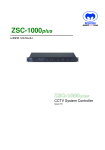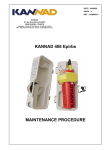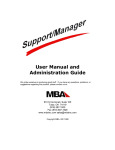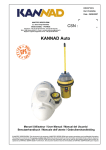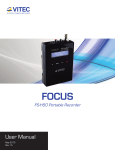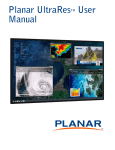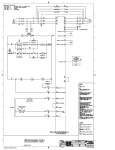Download ARGOS Surface Beacon ASB and ASB X User Manual
Transcript
ARGOS Surface Beacon ASB and ASB X User Manual Version 1.3 February 2008 SiS Sensoren Instrumente Systeme GmbH Mühlenkoppel 12 24222 Schwentinental Germany http://www.sis-germany.com Contents 1. General Information ..............................................................................................2 1.1 Description ........................................................................................................2 1.2 Switch Mode Power Supply Option.................................................................2 2. Operating Instructions ..........................................................................................3 2.1 Choosing Batteries for your Application ........................................................3 2.2 Opening the Housing........................................................................................3 2.3 Insertion of Batteries ........................................................................................3 2.4 Replacement of Moisture Absorbent ..............................................................4 3. Principle of Operation ...........................................................................................4 3.1 MBM Operation .................................................................................................4 3.3 Admission to the Argos System......................................................................4 4. Appendix ................................................................................................................4 4.1 Technical Specification ....................................................................................4 4.2 Warranty and Support ......................................................................................5 List of Figures Figure 1 ASB ..............................................................................................................2 1 1. General Information 1.1 Description The ASB (X) consists of a DELRIN tube closed by end caps. 711 681 100 23 SN plate Delrin cap Internal antenna Delrin tube Delrin cap Scale Date Clrk Chkd Norm Name 02.03.94 Ar Sensoren Instrumente Systeme GmbH Rev Modification Date Name ASB Sheet of 1 1 Figure 1 ASB Inside the housing is a battery holder for two bundles of 5 batteries each in series, the PTT and the antenna. The batteries power the transmitter (PTT) directly or via an optional switch mode power supply (X Option). The ASB (X) is for surface applications. If you need a SMM for deep sea moorings please use the SMM 2000 or SMM 6000 series, or for shallow water up to 500 m depths, use the SMM 500. 1.2 Switch Mode Power Supply Option Instruments marked with an X have the extended battery option. They can be used with a wider selection of battery types. The battery voltage is converted to the right level by a switch mode power converter. For instruments without the X-option, the batteries directly power the transmitter. The X-option may be installed to all systems later. 2 2. Operating Instructions 2.1 Choosing Batteries for your Application The cell voltage has to be between 2.2 V and 5.2 V. For instruments with the X-option the cell voltage has to be between 0.8 V and 5.2 V allowing the usage of alkaline batteries or nickel cadmium accumulators as well. For long term moorings in cold environment we recommend to use high quality Lithium cells. The batteries must be able to source 350 mA continuous current and 1700 mA pulse current. So you should use a battery type which has good efficiency with high currents. This applies especially to Lithium and Lithium Thionyl Chloride Batteries. For calculation of battery lifetime use the average power consumption. Divide the energy content of the 10 batteries by the mean power consumption (100 mW) of the beacon. The table shows typical life times for different battery types: Temperature 20 °C 0 °C -30 °C Lithium battery: Alkaline battery: NC battery: Lithium 150 days 150 days 140 days Alkaline 60 days 50 days not applicable NC 30 days 28 days not applicable Silberkraft Eternacell, Lithium-SO2, Size D, Capacity 10 Ah Philips LR20, Green Alkaline, Size D, Capacity 13.2 Ah Panasonic 4000N, NC, Size D, Capacity 4 Ah For instruments without the X option use the Lithium values only! 2.2 Opening the Housing You open the housing by removing the lower end cap. The cap is fastened by two hexagon socket screws. For opening please screw clockwise thereby turning in the screw into the cap. This paradox solution - screwing in for opening and screwing out for fastening - has the advantage that you won't lose the small screws. When the instrument is opened, screws and end cap build one unit. You then may pull out the cap. When fastening the cap after closing, please note to screw the screws not too tight to avoid stronger stress to the DELRIN main housing. The inner part is fastened at the main tube. 2.3 Insertion of Batteries Don't open the housing by removing the upper cap. Open the housing by removing the lower cap. Put the instrument upside down on the floor and pull out the end cap. You will now find a PVC disc, take it out and you will see two tubing in a PVC block and one contact pin. Put 5 pieces D type batteries into each tube, oriented with the minus terminal in direction of the antenna. 3 If you want the instrument to operate after insertion of batteries close the housing by insertion of the end cap. In case you only want to insert batteries but later want to operate, please place the PVC disk for isolation between batteries and cap. 2.4 Replacement of Moisture Absorbent The printed circuit boards are protected by coating, but condensation of humidity should be avoided. When leaving the factory, the instrument is filled with dry argon gas and a small pack with moisture absorbent is placed in a slot between the battery holder and the at the lower end. We recommend filling with dry gas or replace the moisture absorbent after every opening of the housing. Normally together with battery replacement. With the instrument we deliver some packs with moisture absorbent sealed in a plastic bag and put in a tin. 3. Principle of Operation 3.1 MBM Operation CLS Service Argos has developed a special service for monitoring the status of the moorings (MBM, Moored Buoy Monitoring). An alarm is generated if the buoy goes adrift. A warning that the watch circle is left will be send to the user by email or fax. A warning is also generated if no signal is received from the beacon. Users always may access data on-line (e.g. via Telnet or Web). 3.3 Admission to the Argos System The user must fill out some forms and forward it to the Argos User Office: • Argos System Use Agreement • Service Contract/Order Form Please see the Argos documentation for detailed information. 4. Appendix 4.1 Technical Specification Water proof Dimensions (l x d) Mass without batteries Displacement Power Supply Battery Types without option X Battery Types with option X 10 m 711 x 100 mm 6.7 kg 5.6 dm3 5 or 10 pcs. D cells resp. Lithium or Lithium Thionyl Chloride (1) NC, Alkaline, Lithium or Lithium Thionyl Chloride (1) 2.2 V - 5.2 V 0.8 V - 5.2 V 1700 mA 100 mW up to 6 months 3 or 6 months resp. Serpe IESM Elta / CEIS PTT 07 UHF 88 or HAL2 33 dBm (2 W) 33 dBm (2 W) 32 bits 32 bits 90 seconds 90 seconds 401.650 MHz 401.650 MHz (UHF88) Battery cell voltage (without option X) Battery cell voltage (with option X) Peak supply current Average power consumption Mooring life Transmission life with Lithium cells Transmitter manufacturer (2) Transmitter model (2) Output power Message Length (3) Repetition rate (4) Transmit frequency (5) 4 401.620 MHz 401.630 MHz (HAL2) Notes: 1. The used batteries must be able to source 350 mA continuous current and 1700 mA pulse current. Some low current types of Lithium Thionyl Chloride batteries can’t be used. 2. There are three transmitter models used with the ASB. Instruments manufactured from 2003 to 2006 are equipped with the Serpe IESM PTT 07 model, those made since 2006 are equipped with the Elta HAL2 model while older instruments use the Elta / CEIS UHF 88 model. 3. The ASB did not send any user data. Therefore, the message length is set to the minimum value of 32 bits. With Elta HAL2 transmitters, a prefix byte (typ. 25 hex, with 20-bit ID only), temperature (°C), supply voltage (mV / 64) and power indication (mV / 4) are send. 4. The default repetition rate is 90 seconds (recommended by Argos). Other rates (e.g. 60 seconds) can be programmed upon request. 5. With Elta HAL2 transmitters, the transmit frequency is programmed to 401.630 MHz according to the Argos recommendations. With UHF 88 transmitters, the frequency is fixed at 401.650 MHz. The transmit frequency of PTT 07 is set by the manufacturer. 4.2 Warranty and Support SiS warrants this instrument to the original purchaser to be free of defects in material or manufacturing for a period of two years. Liability is limited to repair or replacement of the defective part which will be done without charge if the instrument is returned to our factory prepaid. This warranty does not apply to instruments subjected to misuse or tampering. No responsibility or warranty for consequential damage is included in the sale of this instrument. SiS - Sensoren Instrumente Systeme GmbH Mühlenkoppel 12, D-24222 Schwentinental, Germany Tel.: +49-431-79972-0 Fax: +49-431-79972-11 Email: [email protected] WWW: http://www.sis-germany.com 5







